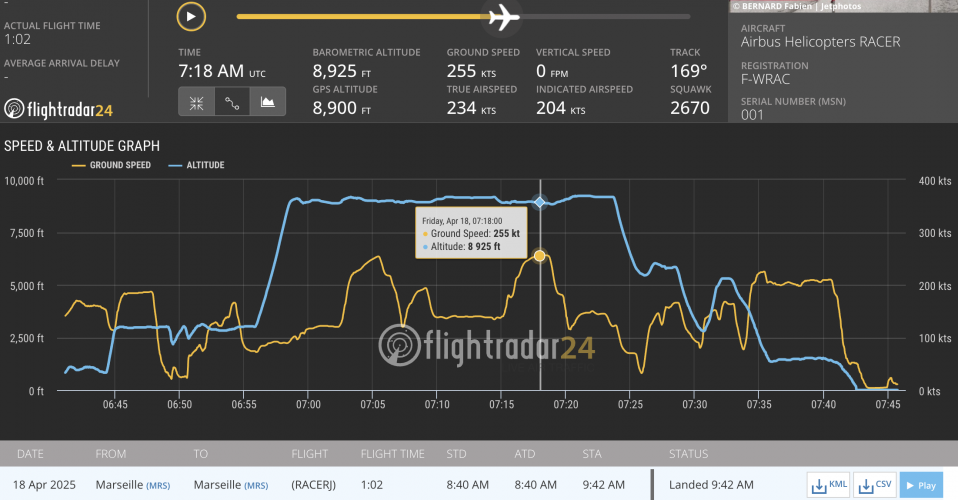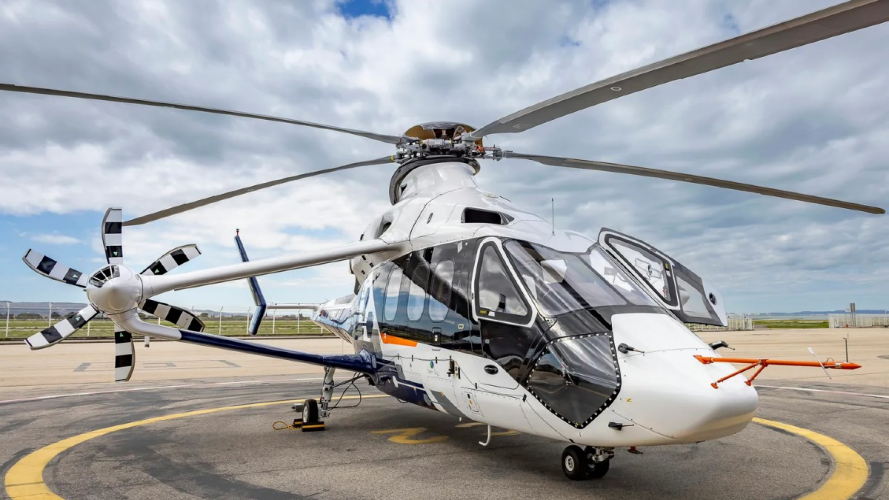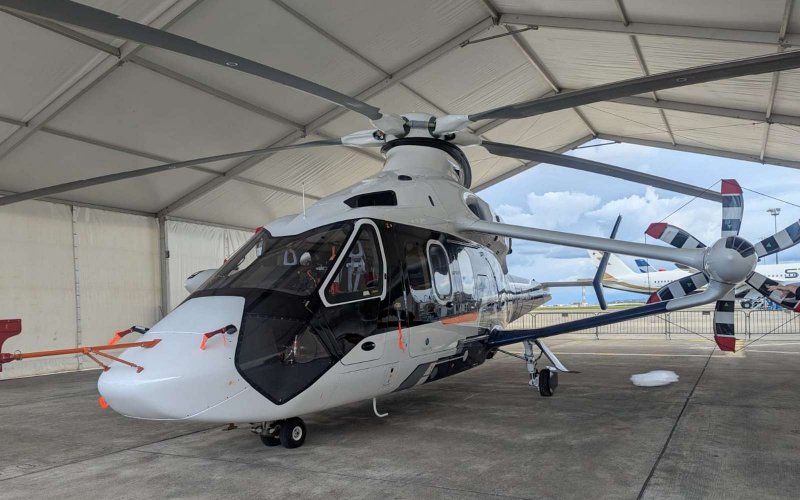You are using an out of date browser. It may not display this or other websites correctly.
You should upgrade or use an alternative browser.
You should upgrade or use an alternative browser.
AIRBUS RACER / Clean Sky2 LifeRCraft Demonstrator
- Thread starter VTOLicious
- Start date
One more test flight today... reached ~215 knots according to Flightradar24.com.
I expect 1-2 more flights this month and hopefully to see them start pushing the envelope to 240+ knots.
Racer MSN001 flight test history
1st flight test campaign
1 | 25/04/2024 | 0:30 hrs | 80 knots
2 | 30/04/2024 | 0:55 hrs | 165 knots
3 | 13/05/2024 | 1:22 hrs
4 | 15/05/2024 | 1:06 hrs
5 | 03/06/2024 | 1:36 hrs | 190 knots
6 | 19/06/2024 | 1:32 hrs
7 | 21/06/2024 | 0:34 hrs | 227 knots
2nd flight test campaign
8 | 06/03/2025 | 0:51 hrs
9 | 14/03/2025 | 0:49 hrs
10 | 19/03/2025 | 0.30 hrs
11 | 22/03/2025 | 1:01 hrs | Marseille-Toulouse
12 | 28/03/2025 | 0:59 hrs | Toulouse-Marseille
Last edited:
Before & after pics of Racer’s new low drag rotor head and landing gear doors.
Rotor head drag is expected to be 25% lower with these low drag fairings.

 www.flightglobal.com
www.flightglobal.com
Rotor head drag is expected to be 25% lower with these low drag fairings.

Racer resumes flight testing with new low-drag parts in place
Airbus Helicopters' Racer demonstrator is back in flight testing after a six-month lay-up to install new parts to boost the high-speed rotorcraft's aerodynamic performance.
Attachments
Last edited:
VNE test yesterday. Racer reached ~260 knots in a dive according to FlightRadar24... perhaps next flight could be a level speed test?
Racer MSN001 flight test history

 www.flightradar24.com
www.flightradar24.com
1st flight test campaign
1 | 25/04/2024 | 0:30 hrs | 80 knots
2 | 30/04/2024 | 0:55 hrs | 165 knots
3 | 13/05/2024 | 1:22 hrs
4 | 15/05/2024 | 1:06 hrs
5 | 03/06/2024 | 1:36 hrs | 190 knots
6 | 19/06/2024 | 1:32 hrs
7 | 21/06/2024 | 0:34 hrs | 227 knots
2nd flight test campaign
8 | 06/03/2025 | 0:51 hrs
9 | 14/03/2025 | 0:49 hrs
10 | 19/03/2025 | 0:30 hrs
11 | 22/03/2025 | 1:01 hrs | Marseille-Toulouse
12 | 28/03/2025 | 0:59 hrs | Toulouse-Marseille
13 | 02/04/2025 | 1:03 hrs | ~260 knots in dive
Racer MSN001 flight test history

Live Flight Tracker - Real-Time Flight Tracker Map | Flightradar24
The world’s most popular flight tracker. Track planes in real-time on our flight tracker map and get up-to-date flight status & airport information.
1st flight test campaign
1 | 25/04/2024 | 0:30 hrs | 80 knots
2 | 30/04/2024 | 0:55 hrs | 165 knots
3 | 13/05/2024 | 1:22 hrs
4 | 15/05/2024 | 1:06 hrs
5 | 03/06/2024 | 1:36 hrs | 190 knots
6 | 19/06/2024 | 1:32 hrs
7 | 21/06/2024 | 0:34 hrs | 227 knots
2nd flight test campaign
8 | 06/03/2025 | 0:51 hrs
9 | 14/03/2025 | 0:49 hrs
10 | 19/03/2025 | 0:30 hrs
11 | 22/03/2025 | 1:01 hrs | Marseille-Toulouse
12 | 28/03/2025 | 0:59 hrs | Toulouse-Marseille
13 | 02/04/2025 | 1:03 hrs | ~260 knots in dive
Last edited:
- Joined
- 18 October 2006
- Messages
- 4,211
- Reaction score
- 4,919
A good day for Airbus. Let's' hope that, unlike other high speed helicopters, the vibratory loads going down hill did not rattle the teeth of the test pilots and require a full tear down of the main rotor system before continuing the flight test program.
WatcherZero
ACCESS: Top Secret
- Joined
- 22 May 2023
- Messages
- 829
- Reaction score
- 1,935
Subsonic rotor blades should reduce vibration considerably.
Scott Kenny
ACCESS: USAP
- Joined
- 15 May 2023
- Messages
- 11,628
- Reaction score
- 14,305
ABC is still supposed to be subsonic rotor tips.Subsonic rotor blades should reduce vibration considerably.
I doubt that vibration is a major risk here, as the X3 demonstrator achieved 255kts in level flight and 263kts in a dive with no vibration issues (in fact the X3 didn’t even need an active vibration control system).Let's' hope that, unlike other high speed helicopters, the vibratory loads going down hill did not rattle the teeth of the test pilots and require a full tear down of the main rotor system before continuing the flight test program.
That said, the wing needs to be very stiff for this type of compound aircraft so perhaps the new joined wing introduced some (small?) risk… but so far Racer’s flight testing seems to have been progressing through test points fairly rapidly and without any obvious issues.
- Joined
- 18 October 2006
- Messages
- 4,211
- Reaction score
- 4,919
Indeed they should since supersonic rotor blades tend to disassemble themselves due to compressibility.Subsonic rotor blades should reduce vibration considerably.
It is good to see the technical agility of Airbus remains in place as rotorcraft requirements change.
VNE test yesterday. Racer reached ~260 knots in a dive according to FlightRadar24... perhaps next flight could be a level speed test?
Racer MSN001 flight test history

Live Flight Tracker - Real-Time Flight Tracker Map | Flightradar24
The world’s most popular flight tracker. Track planes in real-time on our flight tracker map and get up-to-date flight status & airport information.www.flightradar24.com
Quick update on Racer testing. 2 test flights in 1 day and 234 knots true air speed achieved. Still waiting for a full level speed test.
1st flight test campaign
1 | 25/04/2024 | 0:30 hrs | 80 knots
2 | 30/04/2024 | 0:55 hrs | 165 knots
3 | 13/05/2024 | 1:22 hrs
4 | 15/05/2024 | 1:06 hrs
5 | 03/06/2024 | 1:36 hrs | 190 knots
6 | 19/06/2024 | 1:32 hrs
7 | 21/06/2024 | 0:34 hrs | 227 knots
2nd flight test campaign
8 | 06/03/2025 | 0:51 hrs
9 | 14/03/2025 | 0:49 hrs
10 | 19/03/2025 | 0:30 hrs
11 | 22/03/2025 | 1:01 hrs | Marseille-Toulouse
12 | 28/03/2025 | 0:59 hrs | Toulouse-Marseille
13 | 02/04/2025 | 1:03 hrs | 230 knots IAS in dive
14 | 11/04/2025 | 1:16 hrs | 248 knots IAS in dive
15 | 11/04/2025 | 0:41 hrs | 2 test flights in 1 day
16 | 18/04/2024 | 1:02 hrs | 234 knots TAS @ 9,000ft
17 | 22/04/2025 | 0:32 hrs |
18 | 22/04/2025 | 1:08 hrs | 2 test flights in 1 day
19 | 28/04/2025 | 0:42 hrs
20 | 29/04/2025 | 0:45 hrs | 2 test flights in 1 day
21 | 29/04/2025 | 0:29 hrs | 2 test flights in 1 day

Last edited:


